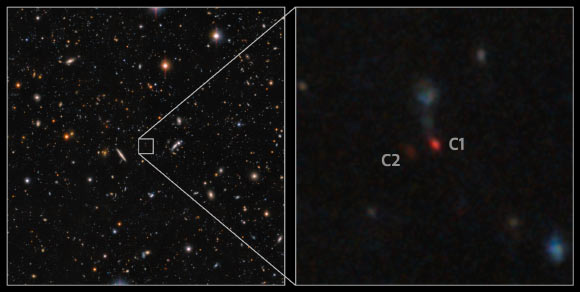Astronomers have discovered a pair of merging quasars seen only 900 million years after the Big Bang. Not only is this the most distant pair of merging quasars ever found, but also the first confirmed pair in the period of the Universe’s history known as Cosmic Dawn.
This image, taken with the Hyper Suprime-Cam on the Subaru Telescope, shows a pair of quasars in the process of merging: HSC J121503.42-014858.7 (C1) and HSC J121503.55-014859.3 (C2). Image credit: NOIRLab / NSF / AURA / T.A. Rector, University of Alaska Anchorage & NSF NOIRLab / D. de Martin, NSF NOIRLab / M. Zamani, NSF NOIRLab.
Cosmic Dawn spanned from about 50 million years to one billion years after the Big Bang.
During this period the first stars and galaxies began appearing, filling the dark Universe with light for the first time.
The arrival of the first stars and galaxies kicked off a new era in the formation of the cosmos known as the Epoch of Reionization.
The Epoch of Reionization, which took place within Cosmic Dawn, was a period of cosmological transition.
Beginning roughly 400 million years after the Big Bang, ultraviolet light from the first stars, galaxies and quasars spread throughout the cosmos, interacting with the intergalactic medium and stripping the Universe’s primordial hydrogen atoms of their electrons in a process known as ionization
The Epoch of Reionization was a critical epoch in the history of the Universe that marked the end of the cosmic dark ages and seeded the large structures we observe in our local Universe today.
To understand the exact role that quasars played during the Epoch of Reionization, astronomers are interested in finding and studying quasars populating this early and distant era.
“The statistical properties of quasars in the Epoch of Reionization tell us many things, such as the progress and origin of the reionization, the formation of supermassive black holes during Cosmic Dawn, and the earliest evolution of the quasar host galaxies,” said Dr. Yoshiki Matsuoka, an astronomer at Ehime University.
About 300 quasars have been discovered in the Epoch of Reionization, but none of them have been found in a pair.
That is until Dr. Matsuoka and their team were reviewing images taken with the Hyper Suprime-Cam on the Subaru Telescope and a faint patch of red caught their eye.
“While screening images of quasar candidates I noticed two similarly and extremely red sources next to each other. The discovery was purely serendipitous,” Dr. Matsuoka said.
The authors were not sure that they were a quasar pair since distant quasar candidates are contaminated by numerous other sources, such as foreground stars and galaxies and the effects of gravitational lensing.
To confirm the nature of these objects, named HSC J121503.42-014858.7 and HSC J121503.55-014859.3, they conducted follow-up spectroscopy using the Faint Object Camera and Spectrograph (FOCAS) on the Subaru Telescope and the Gemini Near-Infrared Spectrograph (GNIRS) on the Gemini North telescope.
The spectra, which break down the emitted light from a source into its component wavelengths, obtained with GNIRS were crucial to characterizing the nature of the quasar pair and their host galaxies.
“What we learned from the GNIRS observations was that the quasars are too faint to detect in near-infrared, even with one of the largest telescopes on the ground,” Dr. Matsuoka said.
This allowed the astronomers to estimate that a portion of the light detected in the optical wavelength range is not coming from the quasars themselves, but from ongoing star formation taking place in their host galaxies.
They also found that the two black holes are whoppers, each being 100 million times the mass of the Sun.
This, coupled with the presence of a bridge of gas stretching between the two quasars, suggests that they and their host galaxies are undergoing a major-scale merger.
“The existence of merging quasars in the Epoch of Reionization has been anticipated for a long time. It has now been confirmed for the first time,” Dr. Matsuoka said.
The discovery is reported in a paper in the Astrophysical Journal Letters.
_____
Yoshiki Matsuoka et al. 2024. Discovery of Merging Twin Quasars at z=6.05. ApJL 965, L4; doi: 10.3847/2041-8213/ad35c7
>>> Read full article>>>
Copyright for syndicated content belongs to the linked Source : Breaking Science News – https://www.sci.news/astronomy/most-distant-pair-merging-quasars-13030.html
